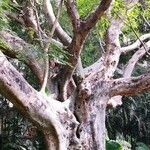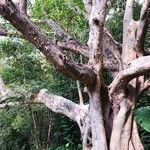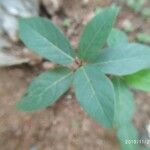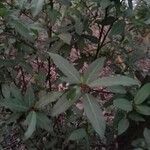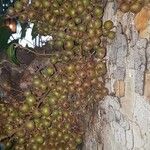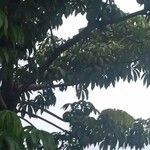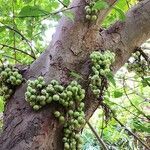| Therapeutic use
|
Abortifacient agents (bark), Acne vulgaris (bark), Analgesics (bark), Angiotensin-converting enzyme inhibitors (bark), Anthelmintics (bark), Anti-bacterial agents (bark), Antifungal agents (bark), Anti-infective agents, local (bark), Anti-inflammatory agents (bark), Antinematodal agents (bark), Anti-obesity agents (bark), Antiprotozoal agents (bark), Antipyretics (bark), Antitussive agents (bark), Appetite stimulants (bark), Asthma (bark), Astringents (bark), Cardiotonic agents (bark), Cholinesterase inhibitors (bark), Contraceptive agents (bark), Dermatologic agents (bark), Diabetes mellitus (bark), Diarrhea (bark), Digestive system diseases (bark), Dysentery (bark), Dyspepsia (bark), Eczema (bark), Edema (bark), Epistaxis (bark), Erysipelas (bark), Female urogenital diseases (bark), Flatulence (bark), Furunculosis (bark), Galactogogues (bark), Genital diseases, female (bark), Gonorrhea (bark), Hemoptysis (bark), Hemorrhage (bark), Hemorrhoids (bark), Hemostatics (bark), Hypoglycemic agents (bark), Inflammation (bark), Insecticides (bark), Leprosy (bark), Leukorrhea (bark), Liver diseases (bark), Lung diseases (bark), Malaria (bark), Mastitis (bark), Menorrhagia (bark), Menstruation disturbances (bark), Mouthwashes (bark), Nootropic agents (bark), Pain (bark), Peptic ulcer (bark), Pharyngitis (bark), Polyuria (bark), General tonic for rejuvenation (bark), Salivation (bark), Skin care (bark), Skin diseases (bark), Snake bites (bark), Stomatitis, aphthous (bark), Syncope (bark), Thirst (bark), Toothache (bark), Ulcer (bark), Urination disorders (bark), Urologic diseases (bark), Vaginal diseases (bark), Vomiting (bark), Wound healing (bark), Wound infection (bark), Wounds and injuries (bark), Diaphoretic (bark), Cooling effect on body (bark), Antifungal agents (flower), Gastrointestinal diseases (flower), Urination disorders (flower), Anthelmintics (fruit), Anti-arrhythmia agents (fruit), Anti-bacterial agents (fruit), Antiemetics (fruit), Anti-inflammatory agents (fruit), Antinematodal agents (fruit), Appetite stimulants (fruit), Asthma (fruit), Astringents (fruit), Improve blood circulation (fruit), Bronchitis (fruit), Contraceptive agents (fruit), Cysts (fruit), Delirium (fruit), Diabetes mellitus (fruit), Diarrhea (fruit), Digestive system diseases (fruit), Diuretics (fruit), Dizziness (fruit), Dysentery (fruit), Dyspepsia (fruit), Edema (fruit), Epistaxis (fruit), Fatigue (fruit), Flatulence (fruit), Gastric acid (fruit), Headache (fruit), Hemoptysis (fruit), Hemorrhage (fruit), Hemorrhoids (fruit), Hypercholesterolemia (fruit), Hypotension (fruit), Inflammation (fruit), Counterirritant (fruit), Jaundice (fruit), Laxatives (fruit), Leukorrhea (fruit), Lung diseases (fruit), Menorrhagia (fruit), Menstrual cycle (fruit), Nervous system diseases (fruit), Pain (fruit), Peptic ulcer (fruit), Polyuria (fruit), General tonic for rejuvenation (fruit), Stomach diseases (fruit), Syncope (fruit), Thirst (fruit), Ulcer (fruit), Urination disorders (fruit), Vaginal diseases (fruit), Vomiting (fruit), Wounds and injuries (fruit), Cooling effect on body (fruit), Abdominal pain (leaf), Allelopathy (leaf), Analgesics (leaf), Anthelmintics (leaf), Anti-arrhythmia agents (leaf), Anti-bacterial agents (leaf), Antifungal agents (leaf), Anti-inflammatory agents (leaf), Antinematodal agents (leaf), Appetite stimulants (leaf), Astringents (leaf), Blister (leaf), Bronchitis (leaf), Cholestasis (leaf), Common cold (leaf), Constipation (leaf), Cough (leaf), Diabetes mellitus (leaf), Diarrhea (leaf), Digestive system diseases (leaf), Dysentery (leaf), Eczema (leaf), Estrogen receptor modulators (leaf), Fever (leaf), Flatulence (leaf), Furunculosis (leaf), Gastrointestinal diseases (leaf), Hemoptysis (leaf), Hemorrhoids (leaf), Hemostatics (leaf), Hoarseness (leaf), Hypotension (leaf), Insecticides (leaf), Jaundice (leaf), Kidney diseases (leaf), Laxatives (leaf), Leukorrhea (leaf), Liver diseases (leaf), Menorrhagia (leaf), Pain (leaf), General tonic for rejuvenation (leaf), Scorpion stings (leaf), Smallpox (leaf), Snake bites (leaf), Stomach diseases (leaf), Ulcer (leaf), Vomiting (leaf), Wound healing (leaf), Wounds and injuries (leaf), Abdominal pain (plant exudate), Abscess (plant exudate), Antifungal agents (plant exudate), Aphrodisiacs (plant exudate), Appetite stimulants (plant exudate), Asthma (plant exudate), Blister (plant exudate), Dermatitis (plant exudate), Diabetes mellitus (plant exudate), Diarrhea (plant exudate), Dysentery (plant exudate), Edema (plant exudate), Foot ulcer (plant exudate), Furunculosis (plant exudate), Gastric acid (plant exudate), Hemorrhoids (plant exudate), Inflammation (plant exudate), Kidney calculi (plant exudate), Lung diseases (plant exudate), Mumps (plant exudate), Periodontitis (plant exudate), Pharyngitis (plant exudate), Skin diseases (plant exudate), Skin diseases, infectious (plant exudate), Sprains and strains (plant exudate), Stomatitis (plant exudate), Stomatitis, aphthous (plant exudate), Toothache (plant exudate), Ulcer (plant exudate), Urologic diseases (plant exudate), Vomiting (plant exudate), Wound healing (plant exudate), Wounds and injuries (plant exudate), Lung diseases (reproductive organ), Tuberculosis (reproductive organ), Anthelmintics (root), Antifungal agents (root), Diabetes mellitus (root), Diarrhea (root), Dysentery (root), Fever (root), Gonorrhea (root), Hypertension (root), Counterirritant (root), Jaundice (root), Laxatives (root), Lung diseases (root), Mental disorders (root), Mumps (root), Rabies (root), General tonic for rejuvenation (root), Sexually transmitted diseases (root), Snake bites (root), Urinary bladder calculi (root), Urination disorders (root), Wounds and injuries (root), Cooling effect on body (root), Anti-bacterial agents (seed), Chickenpox (seed), Diabetes mellitus (seed), Eczema (seed), Hemagglutination (seed), Hypoglycemic agents (seed), Anthelmintics (stem), Diabetes mellitus (stem), Digestive system diseases (stem), Dysentery (stem), Counterirritant (stem), Lung diseases (stem), Malaria (stem), Toothache (stem), Urinary tract infections (stem), Wounds and injuries (stem), Adenopathy (unspecified), Boil (unspecified), Cancer (unspecified), Epididymitis (unspecified), Hydrocoele (unspecified), Lactogogue (unspecified), Menorrhagia (unspecified), Myalgia (unspecified), Orchitis (unspecified), Scabies (unspecified), Spermatorrhea (unspecified), Smallpox (unspecified), Anorectic (unspecified), Antidote(Datura) (unspecified), Ache(Back) (unspecified), Bilious (unspecified), Carminative (unspecified), Cholera (unspecified), Diarrhea (unspecified), Expectorant (unspecified), Fumitory (unspecified), Piles (unspecified), Stomachic (unspecified), Wound (unspecified), Astringent (unspecified), Dysentery (unspecified), Toothache (unspecified), Sore (unspecified), Rinderpest (unspecified), Anti-infective agents, local (unspecified), Antineoplastic agents (unspecified), Appetite stimulants (unspecified), Disorder of ejaculation (unspecified), Furunculosis (unspecified), Hemorrhoids (unspecified), Lactation disorders (unspecified), Leukorrhea (unspecified), Lymphadenitis (unspecified), Menstruation disturbances (unspecified), Sprains and strains (unspecified), Hydrocele (unspecified), Ulcer (unspecified), Urologic diseases (unspecified), Wounds and injuries (unspecified), Astringents (whole plant), Diabetes mellitus (whole plant), Dysentery (whole plant), Disorder of ejaculation (whole plant), Epididymitis (whole plant), Flatulence (whole plant), Furunculosis (whole plant), Lung diseases (whole plant), Lymphadenitis (whole plant), Menorrhagia (whole plant), Orchitis (whole plant), Scabies (whole plant), Sprains and strains (whole plant), Hydrocele (whole plant)
|
